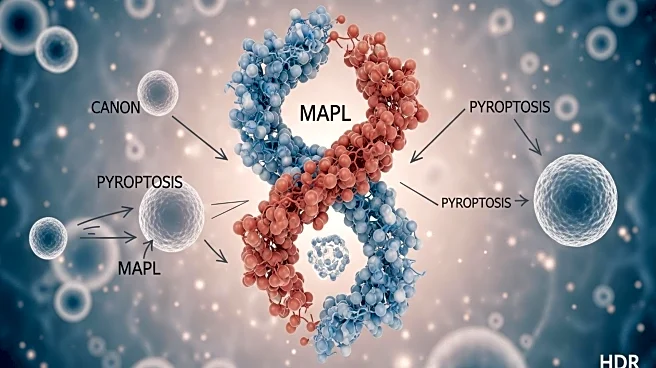What's Happening?
Recent research has identified the mitochondrial outer membrane protein MAPL as a key regulator of pyroptotic cell death, a form of programmed cell death associated with inflammation. The study reveals that MAPL facilitates the release of mitochondrial DNA (mtDNA) from lysosomes, triggering a cascade of immune responses. This process is independent of the traditional BAX/BAK apoptotic pathway, highlighting a novel mechanism of cell death. The findings suggest that MAPL-induced cell death involves the cleavage of caspase-3 and caspase-7, and is mediated by gasdermin proteins, which form pores in the plasma membrane leading to cell rupture. The research utilized genome-wide CRISPR knockout screens to identify genes involved in MAPL-induced pyroptosis, emphasizing the role of inflammatory pathways and immune signaling.
Why It's Important?
Understanding the role of MAPL in pyroptotic cell death has significant implications for medical research, particularly in the fields of cancer and inflammatory diseases. By elucidating the mechanisms through which MAPL regulates immune responses, scientists can explore new therapeutic targets for conditions characterized by excessive inflammation. The discovery of MAPL's involvement in non-apoptotic cell death pathways could lead to innovative treatments that modulate immune signaling, potentially benefiting patients with autoimmune disorders or chronic inflammatory conditions. Additionally, the study provides insights into the complex interactions between mitochondrial function and immune system activation, which are crucial for developing strategies to manage diseases linked to mitochondrial dysfunction.
What's Next?
Future research may focus on further characterizing the molecular pathways involved in MAPL-induced pyroptosis and exploring its potential as a therapeutic target. Scientists could investigate the role of MAPL in various cell types and its impact on different diseases, aiming to develop drugs that can modulate its activity. Additionally, studies might explore the broader implications of mitochondrial DNA release in immune signaling and its potential connections to other forms of cell death. Collaborations between researchers in immunology, oncology, and mitochondrial biology could accelerate the development of novel treatments based on these findings.
Beyond the Headlines
The study of MAPL's role in pyroptotic cell death opens up discussions on the ethical considerations of manipulating cell death pathways for therapeutic purposes. As researchers delve deeper into the molecular mechanisms of cell death, they must consider the potential consequences of altering these processes in humans. The findings also highlight the importance of interdisciplinary research in advancing our understanding of complex biological systems, encouraging collaboration across various scientific fields.











